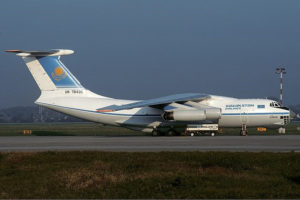
Image: Wikipedia
A Russian Ilyushin Il-76
Do planes ever really crash into each other in the air?
On 12 November 1996, a Saudia Boeing 747 from Delhi to Dhahran, Saudi Arabia and a Kazakhstan Airline Ilyushin Il-76 from Shymkent, Kazakhstan to Delhi collided over Charkhi Dadri around 100 km west of Delhi.
It was the world’s deadliest mid-air collision which killed all 349 people on board both planes.
How was this possible when the planes were supposed to maintain 1000 feet from each other in the air?
According to investigation, the fault was attributed to the Russian pilot who had descended from its assigned altitude of 15,000 feet to around 14,000 feet, the same level of the Boeing 747.
Two factors might have contributed to the collision. One was the possibility of error in computing the altitude.
The Russian-built Ilyushin 76 had an altimeter defined in meters, not feet. As such, pilots had to convert the altitude given to them in feet into meters by reading from a conversion chart.
I remembered when I flew the A330, we took this threat very seriously when flying into China where the metric system was used.
When the controller issued us a level, the co-pilot would diligently read it back and wrote it down.
The captain would check the level by using his metric conversion table, read it aloud and select it on the altitude window.
The co-pilot would then crosscheck it with his conversion table and that the correct altitude was set.
Once these procedures had been done, then only the captain would commence his descent.
No wonder they say, airlines Standard Operating Procedures are written in blood, recognizing that they came about on events that have cost others their lives.
Second reason for the catastrophe was the possibility that there had been a language mix-up between the Indian controller and the pilots who were communicating in English.
To rule out any communication issues, all international airline pilots today must pass an English proficiency test in order to be issued with their licenses.
This accident could not have happened again today because all airliners are fitted with the Traffic Collision Avoidance System (TCAS) designed to prevent any mid-air collisions.
TCAS is capable of showing all surrounding aircraft fitted with transponders and would announce ‘TRAFFIC, TRAFFIC’ if the traffic is close by. When it comes on, pilots would look out for any planes visually.
If there is a danger of colliding, the system will call out ‘CLIMB. CLIMB’ or ‘DESCEND, DESCEND’.
If further action is required the TCAS will even ‘shout’ ‘INCREASE RATE OF CLIMB/DESCEND’ This manoeuvre should be initiated manually by the pilot within seconds.
However, since February 2017, the traffic avoidance can be achieved automatically on the Airbus A330, A350, A380 and on all A320 family when the autopilots are engaged.
Yes, traffic did crash into each other in the past but would be extremely rare today.
Wishing you all a safe flight!
View a YouTube video Charkhi-Dadri mid-air collision